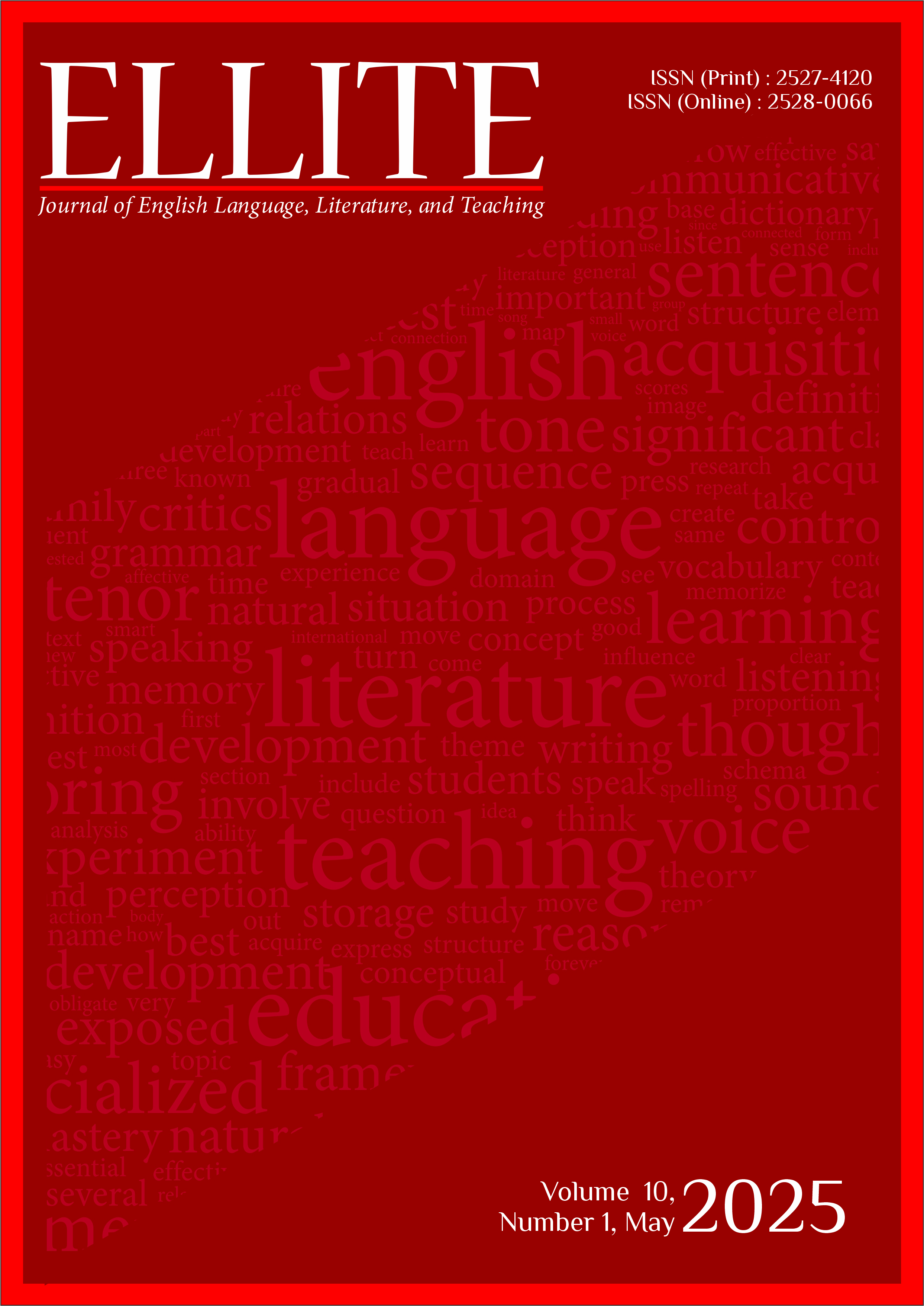Undergraduate Students’ Perception of Humata AI as A Writing Tool for Critical Journal Review (CJR)
DOI:
https://doi.org/10.32528/ellite.v10i1.3049Keywords:
Critical Journal Review; Humata AI; Undergraduate Student’s Perception.Abstract
This study studies about students' perceptions of employing Humata AI for producing Critical Journal Reviews (CJR) and evaluates its advantages and limitations. Six students from a single University conducted semi-structured interviews employing a qualitative technique. Key themes in participant responses were identified using thematic analysis applied to the collected data. The majority of students indicated that Humata AI facilitated a more effective interpretation and evaluation of scientific papers. The primary advantages, particularly with structure and academic language, included the ease of uploading and obtaining journal summaries, increased confidence in writing, and the quality of academic writing. This study, however, also identified some flaws, including excessive dependence on technology, the reliability of analytical results that are not consistently appropriate, and concerns over the originality of student work. Consequently, our research indicates that while Humata AI provides significant benefits to students in the academic analysis process, its use must be complemented by traditional learning methods to ensure the development of critical thinking and independent academic writing skills. The results of this study have implications for educators and educational institutions in the ethical and effective integration into academic writing.
References
Amanda, A., et. al. (2023). Quillbot As An AI-powered English Writing Assistant: An Alternative For Students to Write English. Jurnal Pendidikan Dan Sastra Inggris, 3(2), 188–199. https://doi.org/10.55606/jupensi.v3i2.2026
Amobonye, A., et. al. (2024). Writing a Scientific Review Article: Comprehensive Insights for Beginners. The Scientific World Journal, 2024, 1–13. https://doi.org/10.1155/2024/7822269
Ananda, D. R., & Salmiah, M. (2024). Students ’ perceptions on AI technology: Gemini as a writing assistant tool. Linguistics and English Language Teaching Journal, 12(1), 46–54. https://doi.org/https://doi.org/10.31764/leltj.v12i1.24393
Boone, T., et. al. (1977). SOCIAL LEARNING THEORY Albert Bandura Englewood Cliffs, N.J.: Prentice-Hall, 1977. 247 pp., paperbound. Group & Organization Studies, 2(3), 384–385. https://doi.org/10.1177/105960117700200317
Clarke, V., & Braun, V. (2017). Thematic analysis. The Journal of Positive Psychology, 12(3), 297–298. https://doi.org/10.1080/17439760.2016.1262613
Creswell, J. (1998). Qualitative inquiry and research design: choosing among five traditions.
Crompton, H., & Song, D. (2021). The Potential of Artificial Intelligence in Higher Education. Revista Virtual Universidad Católica Del Norte, (62), 1–4. https://doi.org/10.35575/rvucn.n62a1
Davis, F. D. (1989). Perceived usefulness, perceived ease of use, and user acceptance of information technology.
De Jong, G. (2023). THE APPLICATION OF CRITICAL THINKING IN LITERATURE EDUCATION. Education and New Developments. https://doi.org/10.36315/2023v1end146
De Jong, G. (2024). Effects of critical thinking in literature education. Education and New Developments 2024, 1. https://doi.org/https://doi.org/10.36315/2024v1end126.
Dodgson, J. E. (2021). Critical Analysis: The Often-Missing Step in Conducting Literature Review Research. Journal of Human Lactation, 37(1), 27–32. https://doi.org/10.1177/0890334420977815
Fatkhiyati, N., et. al. (2024). CHILDREN’S LANGUAGE IN THE DIGITAL ERA: ANALYSIS OF CHILDREN’S SPOKEN LANGUAGE VARIETY THROUGH ARTIFICIAL INTELLIGENT AND KAMUS BESAR BAHASA INDONESIA. Celtic : A Journal of Culture, English Language Teaching, Literature and Linguistics, 11(2), 387–404. https://doi.org/10.22219/celtic.v11i2.37797
Fitri, A. R., & Dewi, U. (2024). UNDERGRADUATE STUDENTS’ PREFERENCE AND PERCEPTIONS ON THE USE OF QUILLBOT AND GRAMMARLY AS PARAPHASING TOOLS. Indonesian EFL Journal, 10(2), 167–174. https://doi.org/10.25134/ieflj.v10i2.9868
Franco, J. (2020, February 3). Introducing the Analysis of Journal Articles. https://doi.org/10.33774/apsa-2020-vhjsv
Harris, L., & Brown, G. (2010). Mixing interview and questionnaire methods: Practical problems in aligning data. Practical Assessment, Research and Evaluation, 15, 1–19. https://doi.org/https://doi.org/10.7275/959J-KY83.
Jumariati, J., et. al. (2024). A STUDY ON EFL STUDENTS’ LEVELS OF CRITICAL THINKING SKILLS. Celtic : A Journal of Culture, English Language Teaching, Literature and Linguistics, 11(2), 215–231. https://doi.org/10.22219/celtic.v11i2.33113
Safitri, M., & Fithriani, R. (2024). Exploring Higher Education EFL Students’ Perception of AI Writing Tools in the 5.0 Era. Cetta: Jurnal Ilmu Pendidikan, 7(1), 267–276. https://doi.org/10.37329/cetta.v7i1.3158
Silalahi, R. M. (2025). INDONESIAN UNIVERSITY STUDENTS’ PERCEPTIONS OF CHATGPT FOR ENGLISH ESSAY WRITING [PERSEPSI MAHASISWA INDONESIA TERHADAP CHATGPT DALAM PENULISAN ESAI BAHASA INGGRIS]. Polyglot: Jurnal Ilmiah, 21(1), 1–35. https://doi.org/10.19166/pji.v21i1.8896
Simon, H. A. (1981). Information-processing models of cognition. Journal of the American Society for Information Science, 32(5), 364–377. https://doi.org/10.1002/asi.4630320517
Siregar, H., et. al. (2024). Using Artificial Intelligence ( AI ) Chatgpt As A Writing Tool : Based On Efl Students ’ Perceptions. Jurnal Ilmu Sosial, Humaniora Dan Seni (JISHS), 2(4), 754–760. https://doi.org/http://jurnal.minartis.com/index.php/jishs/article/view/2060
Suryani, I., & Fithriani, R. (2024). Artificial Intelligence Tools in Writing Class: Students’Preferences and Lecturers’Perceptions. Eltin Journal: Journal of English Language Teaching in Indonesia, 12(1), 167–176.
Syahnaz, M., & Fithriani, R. (2023). Utilizing Artificial Intelligence-based Paraphrasing Tool in EFL Writing Class: A Focus on Indonesian University Students’ Perceptions. Scope : Journal of English Language Teaching, 7(2), 210. https://doi.org/10.30998/scope.v7i2.14882
V, S., & S, J. (2024). Impact of Artificial Intelligence in Education. Shanlax International Journal of Management, 11(S1-Mar), 8–11. https://doi.org/10.34293/management.v11iS1-Mar.7992
Vellozo, S. G. (2023). The use of artificial intelligence in the teaching-learning process. III SEVEN INTERNATIONAL MULTIDISCIPLINARY CONGRESS. Seven Congress. https://doi.org/10.56238/sevenIIImulti2023-191
Xu, A., et. al. (2020). Researchers’ views on, and experiences with, the requirement to obtain informed consent in research involving human participants: a qualitative study. BMC Medical Ethics, 21(1), 93. https://doi.org/10.1186/s12910-020-00538-7
Zebua, J. A. Z., & Katemba, C. V. (2024). Students’ Perceptions of Using the OpenAI ChatGPT Application in Improving Writing Skills. Journal of Language and Literature Studies, 4(1), 110–123. https://doi.org/10.36312/jolls.v4i1.1805
Downloads
Published
Issue
Section
Categories
License
Copyright (c) 2025 Anggi Rahmanida Nst, Utami Dewi

This work is licensed under a Creative Commons Attribution 4.0 International License.






